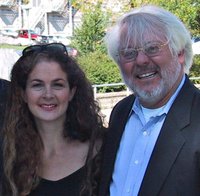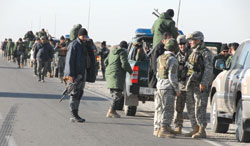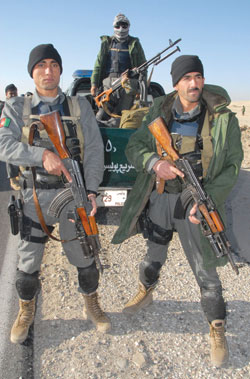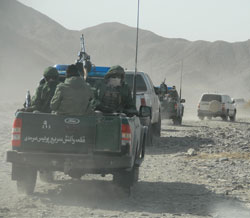
Quick Link
for your convenience!
Human
Rights, Youth Voices etc.
For
Information Concerning the Crisis in Darfur
Whistleblowers
Need Protection

|
|
|
Nothing is certain in Afghanistan except uncertainty
By Robert J. Galbraith, Exclusive to The Suburban
November 14, 2007

|
| Photo by Robert J. Galbraith, The Suburban |
| Afghan Border Patrol prepares to move out of Kabul to Kandahar. |

|
| Border patrolmen in the convoy to Kandahar. |

|
| Photo by Robert J. Galbraith, The Suburban |
In Harm's Way
Soldiers of the pen on the "Highway to Hell" in the land of the poppy. |
|
|
|
To use Robert Galbraith’s words, this was “extreme journalism”. Robert and his colleague Guido Schmidt are in Spin Bolduk, a dangerous Afghan crossing on the Pakistani border. Osama Bin-Laden had been seen here at the start of the conflict. Robert Galbraith has gone further, faster and deeper than any independent journalist in that theatre of war. Each story Robert writes in this series pushes reporting excellence higher. Since there is no internet on the front line, Robert and Guido dictated this story phrase by phrase to me in a series of phone calls spanning a night and a day as they bounced around in the back of trucks of yet another convoy going to the southernmost part of the Afghan-Pakistani border. I interviewed Robert Sunday night by satellite phone on my “Last Angry Man” broadcast on 940 Montreal. I asked what drove him to take such risks. This is his fifth war. To tell the stories, he said. To get the truth out. His greatest joy has been to report the feelings of everyday Afghans who are helped in every way by Canada’s role there and who want us to know it. Last week’s “Voices of Afghanistan” was very important to Robert. Just as in Iraq, Robert goes it alone. He is not embedded. He’s out there. Up front and personal. Rob is all about raw courage. And Bobby Kennedy was right when he said “courage is the cardinal virtue.” Courage draws us to our more noble inclinations. Gives us the grace to throw off the sham and drudgery. And only then can we let in the light. Rob Galbraith is one of those lamplighters.
– Beryl Wajsman, Editor
Spin Bolduk, Afghanistan — Sometimes death slaps you in the face when you see a friend racing down for cover or when the enemy empties its pistols or machine gun in your direction. Other times it comes like a black blanket of absolute fear and deadening horror. It is 4:30 am in Kabul and my colleague Guido Schmidt and I are at the headquarters of the Afghan Border Police. The city is painted in a thick hazy blackness due to there being no street lights and a heavily depleted power supply. We are here to join a 12-truck convoy heading out to one of the world’s most deadly highways. The one that takes you to Afghanistan’s most dangerous region, Kandahar.
Two hours later we are loading into green Ford Rangers (which will be our mode of transportation) when the commander gives the signal for the convoy to start. Pulling out of the police compound, our companions in the vehicle are a driver and a co-driver in the front seat, both with AK -47 assault rifles resting across their laps. I am tightly sandwiched between two AK-47 brandishing guards in the back seat.
In the back of the pick-up are three other officers with black balaclavas and scarves covering their faces, looking like they are prepared for a bank robbery. One is holding an AK-47, another is standing with both hands on the butt and trigger of an oversized machine gun on its rubber mound. The other cradles a rocket-propelled grenade launcher in his hand.
With so much firepower, the ranger looks like a bristling porcupine. Catching me a little groggy and off balance from lack of sleep, I noticed the personnel inside the compound held their hands up at the sight of their bold faces while mumbling a short prayer. As the vehicle turns onto Dalulaman Road leaving the relative security of the compound, the reality of my decision to travel this Highway to Hell hits me like a brick to the forehead, “this could be the last day of my life!”
In a moment of panic I quickly bow my head and pray, “God protect us, any God, please protect us.” Images of my wife and three children flashed through my closed eyes and I continue my prayer. Forgive me for this madness Phyllis, this madness that drives me to do what I do. Creator, protect the ones I love.”
The convoy drives south through the awakening streets of the city as tea and bread makers huddle over their wood-burning ovens that send a thick white smoke into the still air of a stuffy Kabul. Twenty minutes later, we are on the outskirts of the city, and launching onto the Kabul to Kandahar highway (also know as the Ring Road ), as the light breaks the darkness.
Taking a deep breath, I slouch into my seat and thank God for the sunrise. I have traveled on many roads to war, and seen what no people should never wish to see. But I had never been gripped by such helplessness and unwanted anticipation as I had leaving the high-walled compound. That was all behind me now, at least until next I recoil in such fear.
A command is shouted over the radio in the Pashtu language they use. Immediately after, the police officers in the front and back seats roll down their windows and jut their rifles out of them as the convoy picks up speed to 120 km an hour. A cold gush of air streams through the vehicle, turning the interior cab into a freezer.
Trying to keep up with the point vehicle, the convoy blindly crosses the median, hoping that the oncoming traffic of buses, trucks and cars will pull to the side to let them pass. It is white-knuckle driving and then some, which will be ceaseless for the 483-km journey.
Three hours into the harrowing drive we entered the volatile province of Gazni where I start to notice large burned areas of asphalt that scarred the roadway. Burned and mangled tanker and flat-bed trucks are pushed to the side of the road giving evidence for the large road wounds. This is the work of the Taliban.
In between this carnage is the wreckage of head-on collisions. There are no traffic cops outside of Kabul and road signs are just window dressing of wishful thinking. Vehicles pass each other on blind curves, forcing oncoming traffic off the road and into oncoming cars or down gullies. Roadside graves seem almost as regular as the weeds that grow along the edge of it. It is road anarchy, one thing that makes the Mel Gibson movie Mad Max look like it was made right here.
Five hours later we reach the outskirts of Kandahar city. We take the Spin Bolduk-Kandahar bypass heading for the former, avoiding what is locally known as the IED (improvised explosives device) Highway into Kandahar. To not travel that route is refreshing because I have traveled this road before and you are literally a sitting duck for any wacko or Taliban martyr wannabee with a few cakes of plastic explosive and a vest. Or those who can wire a few live artillery shells together, ready to set it off with a cellphone call when the next convoy drives by this death bomb.
We leave this highway target zone, only to realize that the 100- kilometer long Spin Bolduk highway is a nightmare in its own right. This road is like driving through a motorbike motocross course. There is no asphalt. It has been torn up and taken away, leaving the road filled with deep pits and a talcum powder-like dust that rises and obscures your vision worse than a thick Newfoundland fog. Trucks and cars with broken axles, frames and flat tires line the road. It is overly polite describing it as a road. It is an obstacle course over the open desert. Going any faster than 10-20 kilometres an hour will guarantee you bottoming out the frame or unsuspectingly rear-ending another vehicle in the swirling clouds of dust.
Ten hours earlier we were planning a trip to the northern part of Afghanistan, but now we find ourselves 600 km south of Kabul. Once we had reached Kandahar, we had intended to stay in a guesthouse in that city with other journalists with all the comforts of home. Now, we are sleeping on the floor of the officers’ room of the Border Patrol Headquarters in Spin Boldak. This is the most dangerous border zone in Afghanistan, where the Border Patrol has lost 35 men, with 45 injured and 50 vehicles destroyed in just seven months. Men and materiel lost to IEDs, suicide car bombings, and other attacks by the Taliban. The reward for the cramped legs, sore asses, exhaustion, outright fear and tension, is that we found ourselves in what could be a movie set for Lawrence of Arabia. A 250-year-old fortress with two-and-a-half metre thick mud brick walls complete with gun slots for firing at the enemy. On a hillside above us is another fortress that is bathed in a tangerine orange hue formed by the setting sun. In this land of uncertainty at least it is for certain that we will sleep like logs.
This story could not have been done without the collaboration of my friend and colleague Guido Schmidt, and is dedicated to the brave men of the Afghan Border Patrol. We would like to especially thank Gen. Rahman Ajmal and Capt. Rahimi for their openness in allowing us to meet with and witness the Border Patrol at work. |
|
|
